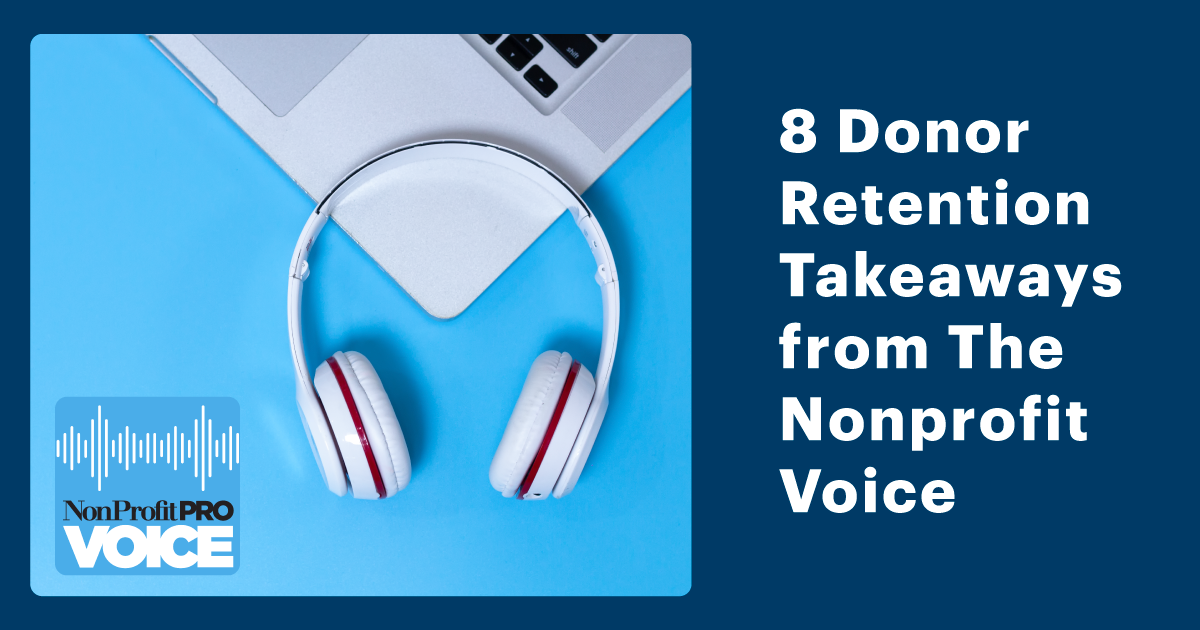
The 2020 DonorPerfect Fundraising Benchmarks Report revealed that the winning strategy for nonprofits striving to weather the COVID-19 pandemic was maintaining strong donor retention rates. Nonprofit organizations that focused on staying connected to existing donors experienced higher growth in giving in 2020 than those who did not.
How can your organization achieve higher donor retention?
DonorPerfect’s CEO, Doug Shoenberg, and development manager of Solano Land Trust, Laura Livadas, discuss successful donor retention strategies with Nhu Te of Nonprofit PRO in the podcast series, The Nonprofit Voice. Here’s what we learned:
How do you increase donor retention?
In this episode of The Nonprofit Voice, Doug sheds light on donor retention trends he’s observed through his partnerships with nonprofit professionals in nonprofit tech, while Laura Livadas shares what has made her development team successful through the COVID-19 crisis:
- Know your donor retention rate
- Maintain detailed data
- Find out how your donors want to be involved
- Use consistent, multichannel communication
- Survey lapsed donors
- Encourage monthly giving
- Showcase what makes you unique
- Seek inspiration from your peers
1. Know your donor retention rate
The saying, “You can’t get to where you’re going if you don’t know where you’ve been” couldn’t be more true! In terms of donor retention, Doug explains: “I think it really starts with, of course, measuring donor retention… And I think the best way to start to improve it is to track it and know whether it’s going up or down.”
Having a baseline for your donor retention can tell you about the success of your overall fundraising efforts. To calculate your donor retention, divide the number of donors who gave again this year by the total number of donors who gave last year.

2. Maintain detailed and complete data
From coding gifts to categorizing donors in your nonprofit CRM, the information you track will help you to explain a drop in donor retention and pinpoint what fundraising campaigns and strategies are working. However, as Laura puts it, your data is “only as good as what you put in.” That’s why it’s important to practice good database health via proper gift and donor data entry. When it’s time to analyze your data, you can trust that your numbers are accurate.
3. Find out how your donors want to be involved
When it comes to donor engagement, one size certainly doesn’t fit all. Doug stresses the importance of knowing the type of relationship your donors want to have with your organization to best cultivate the relationship:
“Some donors are very generous, but they’re also very busy. And candidly, they want to support you with a donation. They don’t necessarily want to get tons of emails, and they may not participate in many of your events and activities. And then there are other donors who are very much looking for that; they want to have an impact beyond their financial donation.”
Doug suggests asking donors about their preferences and understanding what motivates them, then tracking this information in your database, so your team can be mindful in their engagement with them.
4. Use consistent, multichannel communication
Much like friendships, you must earn donors’ trust if you want to hold on to them. As Laura explains, “it’s not easy for us to just make new friends. And this is a scenario that you want [people] to build trust with you, as well. I want them to trust me and know that I’m doing good, good with their money, and I’m producing results.”
Through the COVID-19 pandemic, Laura attributes her organization’s success with donor retention to their commitment to regularly providing their donors with updates on projects and checking in on their wellness through a variety of platforms, such as:
- A quick email update on the status of a project
- An email from the director that addresses current events
- A personal letter or phone call from your staff
- A DIY video shared to your social media channels
- An announcement of a completed project in a local newspaper
- Testimonials shared by your donors and those you’ve helped
5. Survey lapsed donors
It’s good practice to take note of your donors who gave to your organization last year but not again this year and request their feedback. Hearing from those who’ve had firsthand experience with your organization will have the best perspective on ways you can improve your fundraising strategies.
In fact, you may find that the solution could be simpler than you think. Doug explains, “I think a lot of people end up not giving to an organization the following year, not because they’re uninterested in the cause, or that the organization did anything to really offend them, but simply forgetting to do it, or thinking that they did it, etc.”
6. Encourage monthly giving
If you’re losing donors simply because they forget to give or can’t find time, remove these obstacles by offering a monthly gift option that automatically processes their recurring gifts.
The advantage of this giving option is that, over the course of a year, monthly givers tend to give more than one-time givers. Doug explains, “The typical one-time donation is about $50. The average monthly donation is about $30. So, $360 a year. Typically, this means that a monthly recurring donor is worth about seven times more than an average one-time donation.”
In Laura’s experience, monthly donor relationships offer donors a way to give more affordably and can lead to other giving opportunities:
“I think some join the program because they want to do good, but maybe they don’t have the ability to do so much. But they can do monthly, whatever the dollar amount may be. And sometimes that leads into something further down the road, whether it’s a bequest or anything like that. So it opens up much more conversation, and you do begin to gain a relationship with your donors.”
7. Showcase what makes you unique
Podcast host, Nhu, suggests, “Think about what makes you unique. That’s what you can offer your supporters.” For Laura, that meant showing donors the direct impact of their gifts by inviting them onto the land they help protect. When social distancing measures were lightened, Solano Land Trust invited donors outside for coffee and conversation with their executive director. Laura shares, “We were able to show them an in-person, completed project… and we didn’t stop; we didn’t stop talking. We didn’t stop filming and sharing the successes of, not only what their donations are going towards, but the things still happening behind the scenes.”
8. Seek inspiration from your peers
When in doubt, check out what your fellow fundraisers are up to! According to Doug, “there are great opportunities to learn from other nonprofits and constantly be looking for ideas for what’s working for others that you can imitate and emulate.”
Simply start following your fundraising peers on social media and introducing yourself to other businesses in the community. You may even gain a chance to collaborate on an exciting new initiative that your donors will love.
Retain more of your donors with DonorPerfect
Get a DonorPerfect demonstration.





